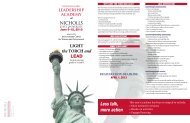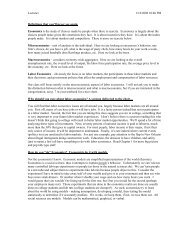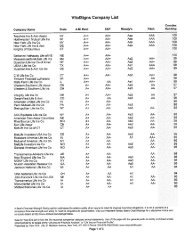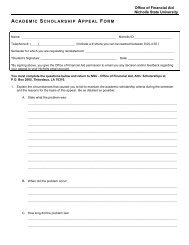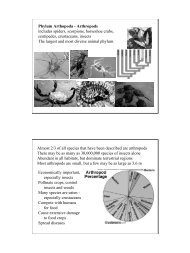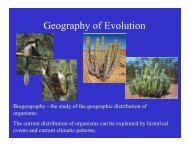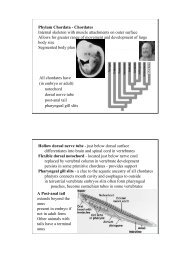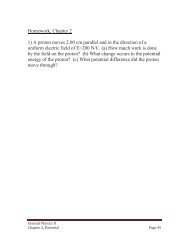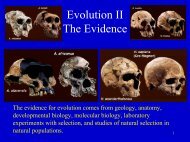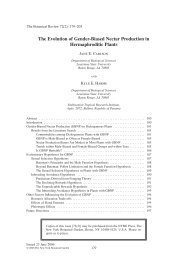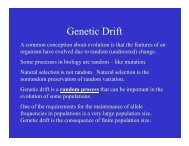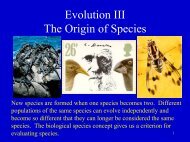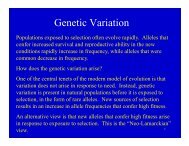Species and Speciation 2.pdf
Species and Speciation 2.pdf
Species and Speciation 2.pdf
You also want an ePaper? Increase the reach of your titles
YUMPU automatically turns print PDFs into web optimized ePapers that Google loves.
<strong>Species</strong> <strong>and</strong><br />
<strong>Speciation</strong><br />
<strong>Species</strong> are different “kinds” of organisms.<br />
<strong>Species</strong> are the product of divergence of genetic lineages.<br />
When one genetic lineage becomes two each lineage<br />
can have an independent evolutionary future.<br />
The difference between species can be slight or dramatic.<br />
Biologists differ in their concept of species. The difference in<br />
concepts used can depend on the group of organisms studied or on<br />
the goal of the researcher who studies them.<br />
• Biological species concept – a population or groups of<br />
populations that are actually or potentially interbreeding <strong>and</strong><br />
reproductively isolated from other populations.<br />
• Evolutionary species concept – a single lineage of populations<br />
that maintains an identity separate from other such lineages <strong>and</strong><br />
which has its own evolutionary tendencies <strong>and</strong> historical fate.<br />
• Phylogenetic species concept – the smallest monophyletic group<br />
distinguished by a synapomorphy.<br />
• Recognition species concept – the most inclusive population of<br />
individual organisms that share a common fertilization system<br />
Ultimately, the idea of a species is a human construct that allows us<br />
to communicate about different forms of life.<br />
1
Deciding what populations constitute a species can be difficult<br />
because reproductive isolation or other species criteria can’t<br />
always be easily assessed.<br />
In practice, species are often identified by consistent differences<br />
in one or more characteristics. This is the phenetic species<br />
concept. Asexual organisms can only be designated phenetically.<br />
It is assumed that<br />
consistent differences<br />
are associated with<br />
reproductive<br />
isolation.<br />
If this is disproven,<br />
then the species<br />
designation can be<br />
revised.<br />
Even though the biological species concept can be problematic in<br />
practice, <strong>and</strong> it only applies to sexually reproducing organisms, it is<br />
the species concept that is most often used by evolutionary biologists<br />
because it seems to correspond to what occurs in nature. Forms that<br />
are reproductively isolated maintain separate identities.<br />
Reproductive isolation – the<br />
restriction of genetic exchange<br />
between groups even when those<br />
groups are sympatric (live in the<br />
same region). The restriction is<br />
often not absolute but sufficiently<br />
restrictive titi so that thteach group<br />
maintains a separate genetic<br />
identity.<br />
A single species can have a range of forms but so long as the forms<br />
are not reproductively isolated, there is the potential for them to<br />
exchange genes <strong>and</strong> share the same evolutionary fate.<br />
2
Because the divergence<br />
of lineages to the point<br />
of reproductive isolation<br />
can be a long process,<br />
many lineages may be<br />
only partially isolated,<br />
or isolated in some areas<br />
but not in others.<br />
The divergence of lineages<br />
can be gradual <strong>and</strong> their<br />
genetic separation may not<br />
become complete. This can<br />
result in hybrid zones. If<br />
those zones are narrow, <strong>and</strong><br />
stable, they may be called<br />
different species<br />
3
Members of one species<br />
often vary geographically.<br />
Intermediate forms often<br />
exist it<strong>and</strong> show evidence of<br />
genetic exchange.<br />
Sometimes geographic<br />
variants of a species are<br />
called subspecies.<br />
Some species, are difficult to distinguish using external <strong>and</strong> easily<br />
observable features, but are reproductively isolated.<br />
Such cases are called “sibling species.”<br />
Sibling species show that appearance is not<br />
the critical criterion for different species.<br />
4
Some plants, classified as different species broadly hybridize.<br />
Populations, subspecies, <strong>and</strong> reproductively isolated species have<br />
gradations of genetic differences.<br />
5
The biological species concept can only be applied to organisms<br />
that are sexual <strong>and</strong> outcrossing. Asexual forms may be called<br />
different species, but a different criterion must be used. For<br />
asexuals two forms are called different species if they differ in<br />
some consistent way.<br />
In spite of difficulties, the biological species concept is broadly<br />
applicable. Many closely related species are reproductively<br />
isolated. There are many barriers to gene flow that result in<br />
reproductive isolation. Barriers are classified as premating or<br />
postmating.<br />
Reproductive isolation is due to barriers to gene exchange<br />
I. Premating barriers – keep species from mating<br />
II. Postmating barriers – mating occurs but gene flow between<br />
species does not occur because of<br />
A. Prezygotic barriers – mating occurs but zygotes are not<br />
formed<br />
B. Postzygotic barriers – zygotes are formed but have<br />
reduced fitness<br />
6
Premating barriers<br />
1. Ecological differences result in<br />
potential mates not meeting<br />
a. Temporal (timing) differences<br />
b. Habitat differences<br />
2. Potential mates meet but do not mate<br />
a. Behavioral differences<br />
b. Pollinator differences<br />
Premating barriers<br />
1. Ecological differences result in<br />
potential mates not meeting<br />
a. Temporal (timing) differences<br />
b. Habitat differences<br />
2. Potential mates meet but do not mate<br />
a. Behavioral differences<br />
b. Pollinator differences<br />
7
Postmating, prezygotic barriers<br />
A. Mechanical barriers – poor fit of mating structures results<br />
in ineffective gamete transfer<br />
B. Copulatory behavioral barriers – mating occurs but there<br />
is no fertilization because of behavioral differences or<br />
lack of proper stimulation<br />
C. Gametic isolation – mating occurs but gametes are<br />
incompatible (lack proper enzymes, attractants, etc.)<br />
8
Postmating, postzygotic barriers<br />
A. Ecological inviability – the hybrid is not fit in either parents’<br />
niche<br />
B. Behavioral sterility – the hybrid is unable to attract either<br />
parental species as a mate<br />
C. Hybrid inviability – the hybrid has reduced survival due to<br />
developmental problems<br />
D. Hybrid sterility – the hybrid has reduced ability to form<br />
viable gametes<br />
Hybrid sterility is most often seen in the heterogametic sex –<br />
males in mammals <strong>and</strong> insects – females in birds <strong>and</strong> butterflies.<br />
This is called “Haldane’s Rule.”<br />
Hybrid problems may not develop in the F 1 offspring, but crosses<br />
among the F 1 <strong>and</strong> backcrosses to the parental species may produce<br />
inviable or sterile offspring . This is called “F 2 breakdown.”<br />
9
Coyne <strong>and</strong> Orr used genetic distance to estimate time of divergence<br />
of many species pairs of Drosophila <strong>and</strong> compared their degree of<br />
prezygotic isolation <strong>and</strong> postzygotic isolation with their divergence<br />
time.<br />
The strength of isolation<br />
increases with time – for both<br />
types of barriers<br />
Full reproductive isolation<br />
evolves with variable amounts<br />
of divergence (0.3 to 0.5) -<br />
~1.5 to 3 million years<br />
Among recently diverged forms the strength of prezygotic isolation<br />
is greater than the strength of postzygotic isolation.<br />
For one species to become two, separate populations of the<br />
same species must become reproductively isolated.<br />
For reproductive isolation to evolve some change must occur<br />
For reproductive isolation to evolve, some change must occur<br />
in one or both lineages in ecology, behavior, physiology,<br />
biochemistry, or genetic system that makes them<br />
reproductively incompatible. How one lineage can become<br />
incompatible with its closest relative lineage is the key<br />
question of how new species are formed.<br />
10
How can an allele that makes an individual reproductively<br />
incompatible with its relatives increase in frequency in a<br />
population?<br />
Dobzhansky-Muller Incompatibility<br />
Allele A 1 increases<br />
in one population<br />
due to fitness<br />
advantages or due<br />
to genetic drift.<br />
Allele B 1 increases<br />
in one population<br />
due to fitness<br />
advantages or due<br />
to genetic drift.<br />
Alleles A 1 <strong>and</strong> B 1 are incompatible with each other <strong>and</strong><br />
hybrids (A 1 A 2 B 1 B 2 ) are either not formed or have low<br />
fitness when the populations come into contact.<br />
<strong>Speciation</strong> can involve the gradual development of<br />
reproductive isolation, or in the case of some types of<br />
chromosomal change, be nearly instantaneous<br />
Gradual speciation can be defined through the geography of<br />
the populations involved.<br />
11
Allopatric speciation is the evolution of<br />
reproductive barriers between populations that<br />
are geographically separated.<br />
When allopatric populations exp<strong>and</strong> their<br />
ranges <strong>and</strong> come into contact they might<br />
• interbreed <strong>and</strong> blend to become a single<br />
continuous species<br />
• interbreed in the region of contact <strong>and</strong> form<br />
a stable tbl hybrid hbidzone<br />
• not interbreed due to some barrier to<br />
reproduction that evolved while they were<br />
allopatric<br />
The evidence for<br />
allopatric differentiation<br />
of geographically<br />
separated populations is<br />
clear<br />
12
Peripheral isolation (peripatric speciation) - the development of<br />
reproductive isolation in small marginal populations of a species.<br />
There are many examples of new species that<br />
arise from single populations of a widespread<br />
species.<br />
This may not be different from simple<br />
allopatric speciation or it may involve some<br />
component of genetic drift.<br />
Moths of<br />
the genus<br />
Greya<br />
13
Mayr hypothesized that founder populations, because they are<br />
small, may have reduced genetic variation <strong>and</strong> low fitness due to<br />
genetic drift. Drift may increase the frequency of alleles that<br />
were rare in the ancestral population. In such a situation,<br />
selection for new combinations of alleles that are compatible with<br />
the newly fixed alleles l may occur <strong>and</strong> allow increased dfitness in<br />
the new conditions. A possible result is a reorganization of the<br />
genome that makes it incompatible with the ancestral population.<br />
Mayr envisioned a fitness topography<br />
where the founder population went<br />
through a low fitness valley due to<br />
drift <strong>and</strong> after selection <strong>and</strong><br />
reorganization, the population<br />
evolved to a new fitness peak that is<br />
incompatible with the ancestral<br />
population.<br />
In theory, natural selection can result in the evolution of barriers<br />
to reproduction while the populations are allopatric.<br />
Alternatively, selection can increase the degree of prezygotic<br />
isolation among populations that have partial postzygotic<br />
isolation.<br />
If the hybrid of two forms has<br />
lower fitness than nonhybrid<br />
offspring, any variation in a<br />
prezygotic barrier in the two<br />
forms may result in selection<br />
that increases the frequency<br />
of the alleles that are the basis<br />
for the barrier.<br />
The preference may be for any prezygotic barrier - ecological or<br />
behavioral.<br />
14
If the fitness of the hybrid is not reduced (there is no postzygotic<br />
isolation), then there will be no selection to reinforce the<br />
prezygotic barrier <strong>and</strong> the populations will likely blend.<br />
Reproductive character displacement - species are more<br />
similar in allopatry than in sympatry.<br />
It can be produced by any selection for prezygotic differences.<br />
It can also the product of competition for resources in the zone<br />
of sympatry.<br />
15
In tree frogs, where partial<br />
postzygotic isolation is known,<br />
song characteristics are most<br />
similar between allopatric<br />
populations pp <strong>and</strong> most different<br />
between sympatric populations.<br />
Females of each species show<br />
greater preference for males of<br />
their own species when they<br />
come from populations that are<br />
sympatric with the other species.<br />
The strength of preference<br />
decreases with the volume of the<br />
call of the other species.<br />
Prezygotic isolation i is stronger among sympatric forms than<br />
among allopatric forms.<br />
There is some evidence that postzygotic isolation can select for<br />
prezygotic differences between species.<br />
16
Parapatric speciation - the origin of new species over the former<br />
range of the ancestral species.<br />
The populations can only diverge if there is<br />
relatively strong selection across the geographic<br />
g range of the species. Often due to an ecological<br />
cline.<br />
A stable hybrid zone may result if there is<br />
moderate selection against the hybrids.<br />
Complete divergence can occur if there is strong<br />
selection against the hybrids - as in reinforcement<br />
of reproductive isolation in formerly allopatric<br />
populations.<br />
Ring species are a special<br />
case of parapatric<br />
speciation over<br />
geographic range.<br />
The ends of the range are<br />
geographically close to<br />
each other but genetic<br />
exchange can only occur<br />
through a great distance.<br />
The ends of the range are<br />
more different from each<br />
other genetically than<br />
any of the intervening<br />
populations.<br />
17
The pattern produced by parapatric speciation <strong>and</strong> the<br />
reestablishment of contact of formerly allopatric populations is<br />
difficult to distinguish.<br />
The best case for parapatric speciation<br />
is in populations of plants on<br />
contaminated soils.<br />
Adaptation to contaminated soils results<br />
in hybrids that are unfit in either<br />
environment.<br />
Selection against hybrids has resulted in<br />
divergence in flowering time in adjacent<br />
populations <strong>and</strong> selection for self<br />
pollination in the population on the<br />
contaminated soil.<br />
Anthoxanthum odoratum - a grass<br />
Sympatric speciation - the development of reproductive isolation<br />
between forms of a species that live entirely in the same<br />
geographic region.<br />
Strong disruptive selection for habitat differences or differences in<br />
reproductive timing may result in divergent phenotypes that<br />
produce hybrids that are unfit for the same environment for which<br />
the parental types are well suited.<br />
Potential scenario: Two homozygous genotypes A 1 A 1 <strong>and</strong> A 2 A 2 are<br />
well suited to different host plants <strong>and</strong> their hybrid A 1 A 2 has low<br />
fitness on both host plants. If another gene is introduced that<br />
produces a difference in mating behavior that is correlated with the<br />
host plant it will reinforce mating among like genotypes <strong>and</strong><br />
potentially lead to complete divergence.<br />
18
Apple maggot flies may be a case of the<br />
beginning stages of sympatric speciation.<br />
The apple race emerges<br />
early <strong>and</strong> parasitizes apples.<br />
The Haw race emerges late<br />
<strong>and</strong> parasitizes haws. Any<br />
mating between a late apple<br />
fly <strong>and</strong> an early haw fly will<br />
produce hybrids with an<br />
intermediate emergence time<br />
with fewer opportunities to<br />
parasitize apples.<br />
Those that avoid mating with the other race will produce offspring<br />
with emergence times appropriate for apples or haws.<br />
The two races already show some preferences in mating for<br />
members of their own race.<br />
<strong>Speciation</strong> by polyploidy <strong>and</strong> recombination<br />
Hybrid organisms receive two different sets of chromosomes, one<br />
from each parent species. They are usually sterile because<br />
differences in gene arrangements among chromosomes results in<br />
improper synapsis <strong>and</strong> aneuploid gametes.<br />
Duplication of<br />
whole sets of<br />
chromosomes<br />
(allopolypoidy)<br />
may result in<br />
gametes that<br />
can produce<br />
balanced sets of<br />
chromosomes.<br />
19
Allopolyploids with a diploid number of sets of chromosomes<br />
from each parent (2N A + 2N B ) produce gametes that are euploid<br />
with one set of chromosomes from each parent (N A + N B ).<br />
Such organisms are potentially interfertile or self-fertile but they<br />
can’t produce fertile offspring in backcrosses with either parent<br />
species.<br />
Gamete (N A + N B ) combined with gamete (N A ) produces an<br />
allotriploid (2N A + N B ) that produces unbalanced sets of genes in<br />
gametes.<br />
Thus, allopolyploids are reproductively isolated from each of<br />
their parent species. They can only reproduce with other<br />
allopolyploids or through self-fertilization. They are new species<br />
as soon as they are formed.<br />
Many species of plants <strong>and</strong> some animals are polyploid. At least<br />
50% of all flowering plants are polyploid.<br />
Read: Evolutionary History of Humans<br />
20
Classically there have<br />
been two hypotheses for<br />
the evolution of humans,<br />
the multiregional<br />
hypothesis - modern<br />
Homo sapiens evolved<br />
simultaneously<br />
throughout the old world<br />
from archaic Homo<br />
sapiens with exchange of<br />
genetic information by<br />
gene flow<br />
<strong>and</strong> the out-of-Africa<br />
hypothesis - modern<br />
humans evolved in<br />
Africa <strong>and</strong> moved out<br />
replacing previously<br />
widely dispersed<br />
archaic humans<br />
21
Mitochondrial DNA analysis of modern<br />
humans suggests that Asian, European,<br />
Australian <strong>and</strong> Indonesian populations<br />
all share a common ancestor that<br />
dispersed from Africa about 80,000<br />
years ago. Multiple dispersals out of<br />
central Asia appear to account for<br />
European populations.<br />
22
Read: Did Humans <strong>and</strong> Ne<strong>and</strong>erthals Interbreed?<br />
23



